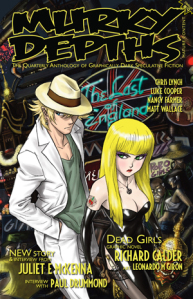
Authors who don’t read are like farmers who don’t eat. They are dead of starvation, all of their dependents perished for lack of food, and all of society collapses. Damn. Actually, that’s more of an analogy for how much more important agriculture is to society than art. Thanks farmers!
Okay, authors who don’t read are like barbers who don’t know how to use scissors or shave with a straight razor — which is every barber where I live. They just give clipper cuts. You can do that yourself at home! I bet they don’t even have a license. So yes, unread authors have the societal value of unlicensed barbers, placing them well beneath farmers and slightly below teenage car wash fundraisers in terms of absolute worth.
Read a book!
I did.

This month, I finished Hunter’s Run by George R.R. Martin, Gardner Dozois, and Daniel Abraham. I wish I had quit reading a quarter of the way through, around the time when I first thought, “I hope this book gets better.” It didn’t get better. It was inspired by Tom Sawyer taking a river raft ride up a painful catheter insertion. The first is alluded to, the latter overtly mentioned.Then again, I learned an important lesson from this book, and the afterword, like most afterwords, filled me with an accustomed sense of grief and regret.
I write some despicable characters. I’m pretty good at it, because it is easier for me to express the worst and dread the best, as though acknowledging goodness is like asking for a refund. I’ve consistently been told that my characters could be more likeable, but I have taken that advice with a grain of salt.

Hunter’s Run features a Mexican protagonist, Ramon Espejo, on account of the authors having noted a dearth of Hispanic characters thirty-years-ago when they had first started writing the novel. It’s an admirable sentiment, except that the end result all of this time later is a walking billboard for Trump’s deportation policies. Espejo is a Quentin Tarantino-esque caricature of a B-movie Danny Trejo/Rob Schneider love child, ostensibly an antihero, but actually more of a schmuck whose dialogue reads like excerpts from Spanish Invective for Dummies. Sadly, he lives through the entire book, because a world without him would be a much more interesting place. The otherwise intriguing setting is so diminished by his involvement that it feels like going to the Oscars and getting seated between Carrot Top and a suicide bomber. Espejo is worse than an unlicensed barber.

Hunter’s Run showed me that there is a point at which an antihero devolves from an unconventional protagonist into an irredeemable asshole. A character like that can’t even be considered a villain. He’s just the guy whose SUV takes up two parking spaces in a busy lot. Who cares about his backstory? He’s the doormat between good and evil, but it’s the muddy boot prints that I care about. A doormat is not the hero of its own story.
Somebody in my stories needs to be likeable. There needs to be an emotional connection on some level, which doesn’t necessarily have to reflect positive qualities but does need to be a congenial symptom of the human condition. George Lucas botched that premise when he introduced Jar Jar Binks into a story about senatorial proceedings, monastic warriors infected with some kind of supernatural STD, and a mute villain named after a wood splitting tool. Binks was the light side counterpart of Espejo, a hero whose sheer obnoxiousness translates into the same sort of asshattery. They are the Yin and Yang of crap characters.

But the man is the world, as we see the world through his eyes and experience its subjectivity. If the man is not greater than the world around him — more vibrant, flawed, fragile, what-have-you — then the reader spends his time looking out the window, awaiting the next chapter, like road signs on a long car ride. That’s the escapism of literature, a world filtered through eyes that are not our own — eyes that perceive more than we do in our daily lives, and a mind that re-contextualizes what we mistake for the mundane. I can do better in this way.
The sense of loss that I felt isn’t something specific to this book. Afterwords are an opportunity for authors to reminisce and maybe grandstand a little. Their stories are often fascinating (not in this case), but they fill me with a sense of mourning for the life that I thought I would have and where I once thought I would be today. This book describes a collaboration between three authors spanning thirty years. This is the first book that I’ve read by any of them, so my only exposure to George R.R. Martin’s work has been seeing a few dragons and about two dozen pornos worth of boobies on HBO in his fantasy/medieval adaptation of marry, boff, kill, Game of Thrones. Reading about his accomplishments and the fraternity between these men brings to mind an exchange between Dave Foley (Dave Nelson) and Phil Hartman (Bill McNeil) from the show, News Radio:
Bill: Did you know that when Dan Rather was 19 he was the youngest photographer for the Associated Press?
Dave: Okay, well, what were you doing at 19?
Bill: Drinking.
Dave: Well, how about how hard it was to break into the industry? You know, all the struggles…
Bill: My aunt owned a radio station. She hired me to try to get me to stop drinking.

That sums up about ten years of my life. While these three guys were building their careers, getting published, and making connections at workshops, “there I was… watching it on TV in my dorm and drinking.” I can live with that, and I nearly moved past it. But now I am faced with a nearly equivalent span of idle years, wondering if I could have better balanced a writing career with my caregiver duties were it not for some deficiency of character, if those years of drinking to avoid pain had been devoted instead to laying a foundation that could weather the hard years ahead. I kept my daughter alive (yes, you did too, but the odds were against us in this case). That should be enough, but it is an isolating and all-consuming experience, so that reading about the accomplishments of successful authors leaves me feeling like Rick Moranis in Ghostbusters, slamming his hands against the pane of glass that separates him from a room of fine diners while his own personal demon lurches up behind him.





